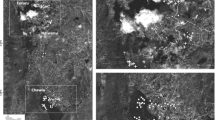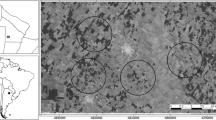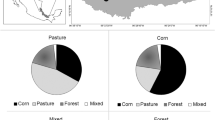Abstract
Destruction and fragmentation of tropical rain forest result in a loss of species and of generating capacity of the ecosystem via animal vectors such as seed dispersal agents. To gather quantitative data regarding this ecological problem, birds and mammals were censused in 30 forest fragments, 15 agricultural islands representing five types of vegetation (coffee, cacao, citrus, pepper and mixed-crops) and in three pastures in Los Tuxtlas, southern Veracruz, Mexico. More than 6000 animals of 257 species were detected thus suggesting the existence of a rich species pool in the fragmented landscape. Frugivores accounted for 60% of species, for 72% of individuals censured and for 85% of the total animal biomass recorded. Clusters of small forest fragments (< 100 ha) were richer in species and individuals than clusters of large area (> 100 ha) forest islands. Pastures were especially poor in forest birds and mammals. While the agricultural islands studied contributed to only 1% of the total area of vegetation sampled, they contained 58% of all species detected and 34% of all individual birds and mammals censured. Recaptures indicated inter-island movements of forest birds and mammals. Forty percent of the species were detected in forest habitats only, the rest were detected in forest and in agricultural habitats. Seeds of forest interior plants dispersed by birds and bats were detected in the agricultural habitats. The value of agricultural islands as landscape features providing some degree of biotic connectivity among fragmented animal populations is discussed.
Access this chapter
Tax calculation will be finalised at checkout
Purchases are for personal use only
Preview
Unable to display preview. Download preview PDF.
Similar content being viewed by others
References
Blake, J. G. 1991. Nested subsets and the distribution of birds on isolated woodlots. Cons. Biol. 5: 58–66.
Brown, J. H. & Kodric-Brown 1977. Turnover rates in insular biogeography: effect of immigration on extinction. Ecology 58: 445–449.
Burkey, T. V. 1989. Stochastic extinction in nature reserves: the effect of fragmentation and the importance of migration between reserve fragments. Oikos 55: 75–81.
Estrada, A., Coates-Estrada, R. & Martinez, M. 1985. La Estacion de Biologia ‘Los Tuxtlas’: un recurso para el estudio y conservacion de la selvas del tropico humedo en Mexico. In: del Amo S. & Gomez-Pompa, A. (eds) Regeneration de Selvas II. Instituto Nacional de Investigaciones sobre Recursos Bioticos. Editorial Alhambra Mexicans S. A. de C. V. Mexico. Pp. 379–393.
Estrada, A. & Coates-Estrada, R. 1988. Tropical rain forest conver-sion and perspectives in the conservation of wild primates (Alouatta and Ateles) in Mexico. Am. J. Prim. 14: 315–327.
Ewens, W. J, Brockwell, J., Gari, M. & Resnick, S. I. 1987. Minimum viable population size in the presence of catastrophes.In: Soule, M. E. (ed) Viable populations for conservation.Cambridge University Press, Cambridge, England.Pp. 59–68.
Gilbert, L. E. 1980. Food web organization and conservation of neotropical diversity. In: Soule, M. E. & Wilcox, B. A. (eds) Conservation biology: an evolutionary-eco-logical perspective. Sinauer Assoc., Sunderland, Mass. Pp. 11–33.
Hopkins, M. S. & Graham, A. W. 1984. Viable soil seed banks in disturbed lowland tropical rainforest sites in north Queensland. Austr. J. Ecol. 9: 71–79.
Hubbel, S. P. & Foster, R. B. 1986. Commoness and rarity in a neotropical forest: implications for tropical tree conservation.In: Soule, M. E. (ed) Conservation biology: the science of scarcity and diversity. Sinauer Assoc., Sunderland,Mass. Pp. 205–231.
Janzen, D. H. 1983. No park is an island: increase in interference from outside as park size decreases. Oikos 41:402–410.
Karr, J. 1982a. Avian extinction on Barro Colorado Island, Panama; a reassessment. Am. Nat. 119: 220–239.
Karr, J. 1982b. Population variability and extinction in the avifauna of a tropical land-bridge island. Ecology 63: 1975–1978.
Karr, J. 1991. Biological integrity and the goal of environmental legislation: lessons for conservation biology. Cons. Biol.4: 244–250.
Klein, B. C. 1989. Effects of forest fragmentation on dung and carrion beetle communities in central Amazonia. Ecology 70: 1715–1725.
Laurance, W. F. 1991. Ecological correlates of extinction proneness in Australian tropical rain forest mammals. Cons. Biol. 5: 79–89.
Laurance, W. F. & Yensen, E. 1991. Predicting the impacts of edge effects in fragmented habitats. Biol. Cons. 55: 77–92.
Leighton, M. & Leighton, D. R. 1983. Vertebrate responses to fruiting seasonality within a Bornean rain forest. Pp. 181–196. In: Sutton, S. L., Whitmore, T. C. & Chad-wich,A. C. (eds) Tropical rain forest: ecology and management.Blackwell Scientific Publications, Oxford, England.
Lomolino, M. V. 1986. Mammalian community structure on islands: the importance of immigration, extinction and interactive effects. Biol. J. Linn. Soc. 28: 1–21.
Lovejoy, T. E., Bierregaard, R. O., Brown, K. S., Emmons, L. H. & Van der Voort, M. E. 1984. Ecosystem decay of Amazon forest fragments. In: Niteki, M. H. (ed) Extinctions.University of Chicago Press, Illinois. Pp. 295–325.
Lovejoy, T. E., Bierregaard, R. O. Jr., Rylands, A. B., et al 1986. Edge and other effects of isolation on Amazon forest fragments. In: Soule, M. E. (ed) Conservation biology: a science of scarcity and diversity. Sinauer Assoc., Sunderland,Mass. Pp. 257–285.
Lynch, J. F. & Whitcomb, R. F. 1978. Effects of insularization of the eastern deciduous forest on avifaunal diversity and turnover. In: Marmemstein, A. (ed) Classification inventory and analysis of fish and wildlife habitat. U. S. Fish and Wildlife, Washington, D. C. Pp. 461–489.
Myers, N. 1988. Tropical forests: much more than stocks of wood. J. Trop. Ecol. 4: 209–221.
Newmark, W. D. 1991. Tropical forest fragmentation and the local extinction of understory birds in the eastern Usambasa Mountains, Tanzania. Cons. Biol. 5: 67–78.
Pickett, S. T. A. & Thompson, J. N. 1978. Patch dynamics and the design of nature reserves. Biol. Cons. 13: 27–37.
Saunders, D. A., Hobbs, R. J. & Margules, C. R. 1991. Biological consequences of ecosystem fragmentation: a review. Cons. Biol. 5: 18–32.
Soule, M. E. 1987. Viable Populations for Conservation. Cambridge University, Press, New York.
Terborgh, J. 1976. Island biogeography and conservation: strategy and limitations. Science 193: 1029–1030.
Terborgh, J. 1986. Keystone plant resources in the tropical forest. In: Soule, M. E. (ed) Conservation biology: the science of scarcity and diversity. Sinauer Assoc., Sunderland, Mass. Pp. 330–334.
Walker, B. H. 1981. Is succession a viable concept in African savannah ecosystems? In: West, D. C., Shugart, H. H. & Botkin, D. B. (eds) Forest Succession: Concepts and application.Springer, New York. Pp. 431–447.
Wilcox, B. A. 1978. Supersaturated island faunas: a speciesage relationship for lizards on post-Pleistocene land-bridge islands. Science 199: 996–998.
Willis, E. O. 1974. Populations and local extinctions of birds on Barro Colorado Island, Panama. Ecol. Mon. 44: 153–169.
Zimmerman, B. L. & Bierregaard, R. O. 1986. Relevance of the equilibrium theory of island biogeography and speciesarea relations to conservation with a case from Amazonia. J. Biogeo. 13: 137–143.
Author information
Authors and Affiliations
Editor information
Rights and permissions
Copyright information
© 1993 Springer Science+Business Media Dordrecht
About this chapter
Cite this chapter
Estrada, A., Coates-Estrada, R., Meritt, D., Montiel, S., Curiel, D. (1993). Patterns of frugivore species richness and abundance in forest islands and in agricultural habitats at Los Tuxtlas, Mexico. In: Fleming, T.H., Estrada, A. (eds) Frugivory and seed dispersal: ecological and evolutionary aspects. Advances in vegetation science, vol 15. Springer, Dordrecht. https://doi.org/10.1007/978-94-011-1749-4_18
Download citation
DOI: https://doi.org/10.1007/978-94-011-1749-4_18
Publisher Name: Springer, Dordrecht
Print ISBN: 978-94-010-4767-8
Online ISBN: 978-94-011-1749-4
eBook Packages: Springer Book Archive




